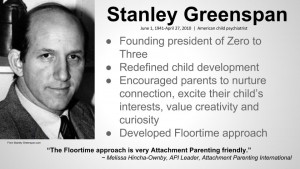Attachment Parenting is based on more than 60 years of solid, interdisciplinary research into parent-child relationships, from infant bonding and breastfeeding to nurturing touch and discipline. We have a long line of researchers — and advocates helping to incorporate their findings into society — to thank for how we look at families today: that how parents interact with their children matter, in real time and over the lifetime, in child development.
 One of those scientific greats — recognized by Attachment Parenting International (API) during our 20th Anniversary celebration in 2014 — was the late Stanley Greenspan, an American child psychiatrist who redefined child development. His work led to a change in how parents view the value of nurturing — encouraging them to cultivate connection with their children, excite their child’s interests, and value creativity and curiosity.
One of those scientific greats — recognized by Attachment Parenting International (API) during our 20th Anniversary celebration in 2014 — was the late Stanley Greenspan, an American child psychiatrist who redefined child development. His work led to a change in how parents view the value of nurturing — encouraging them to cultivate connection with their children, excite their child’s interests, and value creativity and curiosity.
Dr. Greenspan also developed Floortime therapy, a treatment approach for children with autism and developmental disabilities that addresses the speech, motor and cognitive skill delays of affected children holistically, via emotional development and interpersonal communication, through the parent-child attachment relationship.
Very simply, Floortime happens when parents get down on the floor and engage with their children through play. Key to Floortime is that the parent enters the child’s games at the child’s development level and follows the child’s lead in those games. A therapist is then able to guide the parents on how to encourage their child to increasingly complex interactions. For example, if the child is tapping an object, the parent could join in by tapping the object in the same manner. To encourage interaction, the parent might then introduce a new object and eventually add a language element.
In observance of World Autism Awareness Day on April 2, this week’s featured article is “What We Know About Autism: Separating the Science From the Scandal” in Vogue, written by health journalist Lauren Mechling.
In the article, we learn that autism is no rare medical condition. In fact 1 in 68 American children — more often boys — is on the spectrum. While it appears that the disorder is much more prevalent than it was 40 years ago, high detection rates rooted in being better informed of early signs is at least partly behind this trend.
While the cause of autism remains largely unknown, researchers agree that it is likely a complex mixture of genetic and environmental factors.
Treatment options seem just as vague, with no drug treatments developed specifically for core autism symptoms. The article continues on, identifying that the most effective treatment currently is early detection combined with intervention therapies aimed at helping young children build neural pathways through face-to-face interaction with a caregiver during Floortime.
And that’s thanks to Dr. Greenspan.
API Resources for Parenting & Autism
Many parents of children on the spectrum find attachment-based parenting choices to be critical to developing positive relationships with their children. API has many resources for parents of children with autism, including:
Personal stories on APtly Said, API’s blog —
“Attachment Parenting and autism”
“Today is World Autism Awareness Day 2010”
Professional insight and a few more personal stories on The Attached Family, API’s online magazine —
“An Attachment Parenting approach to autism”
“Autism: Interview with pediatrician Dr. Robert Sears”
“From heartache to hope: Interview with Leisa Hammett of The Autism Society of Middle Tennessee”
“A boy brought back from autism”
“Different, not disordered: Interview with Dr. Barbara Probst“
Additional resources from API —
Audio recording with Dr. Robert Sears about treating autism — only $9
The documentary, “Kids with Cameras,” following children with autism as they learn how to express themselves through films, poems, painting and music — now just $15
